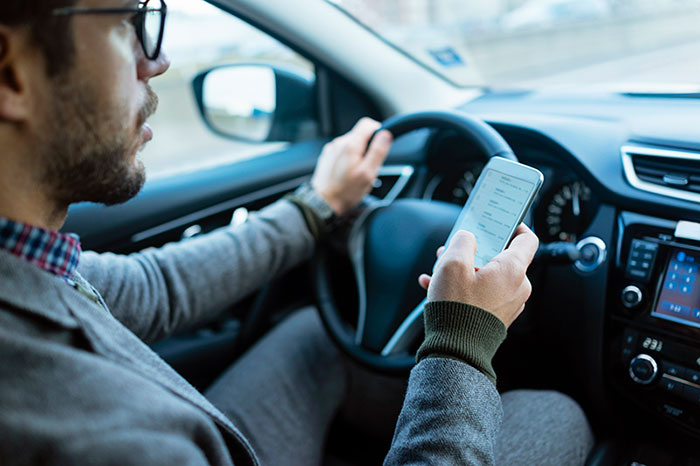
We live in a fast paced world with busy lives and jam-packed to do lists. Unfortunately, the Earth has refused to change its habits and each day is still only 24 hours. As an industrious species we invented multitasking to help us keep pace with our lives, our lists and check all those boxes. Multitasking, with support from its enabler technology, comes at a cost. That cost is our focus, paid for in the form of distractions.
Consequences of Distraction
The cost of multitasking is particularly hefty when we get behind the wheel of a vehicle and drive. Distracted Driving as defined by the NHTSA, a division of the U.S. Department of Transportation, is any activity that diverts attention away from the task of driving, including but not limited to talking or texting on your phone eating and drinking, talking to people in our vehicle, adjusting the stereo or navigation system—any of these actions can endanger the driver, passengers and anyone who is on the road with the distracted driver.
Distracted driving is a costly endeavor with far reaching consequences that negatively impact lives, communities and businesses. A few statistics to consider:
- A single distracted driving citation can raise insurance rates from $87 to $762. Fines for distracted driving citation vary state to state can range from $25 to upwards of $1000 but nearly every state has laws addressing the issue.
- In the U.S. 9 people are killed every day due to car crashes involving a distracted driver
- In 2017 3,166 people were killed by distracted driving.
To see your state’s distracted driving laws visit Governor’s Highway Safety Association webpage.
Distraction by Type
The NHSTA identifies 3 types of distractions that impair drivers:
- Manual: A physical action or movement in which the driver taking their hands off the wheel and/or physically diverts their body from the road, such as changing the radio station or searching for an item in the car.
- Visual: A driver diverts their eyes to something other than the task of driving—looking at phone, someone in the car, something outside the car such as an accident.
Cognitive:This type of distraction occurs when the driver focuses mentally on something other than the task of driving, such as daydreaming or thinking about work problems or even focusing on a conversation within the vehicle.
 As far as the types of distractions, texting while driving is especially dangerous because it requires visual, cognitive and physical shifts in focus. To answer a call, read or respond to a text a driver must not only divert their eyes from the road but also mentally divert their attention to consume information and physically move their body by either removing a hand from the wheel or turning their head to access and/or view information.
As far as the types of distractions, texting while driving is especially dangerous because it requires visual, cognitive and physical shifts in focus. To answer a call, read or respond to a text a driver must not only divert their eyes from the road but also mentally divert their attention to consume information and physically move their body by either removing a hand from the wheel or turning their head to access and/or view information.
Despite the inherent danger of texting and driving, over 660,000 drivers use electronic devices while driving according to research conducted by the NHSTA. To illustrate the danger, NHSTA study also provides the average time it takes read a text is 5 seconds. It may not sound like much but 5 seconds is how long it takes a person driving 55pmh to travel the length of a football field, except if they are looking at their phone it would be like doing it blindfolded. What’s really scary is that on average people admit to spending 13 minutes a day on their phones while driving. I’ll leave you to do the math for how many blind football fields that equals.
Below are some tips to help you minimize distractions, improve your focus and protect not only yourself but others:
Turn it Off and Tune In
Set yourself up for a safe drive by setting your mobile device to “Driving Mode”, put messages and chat groups on “Do Not Disturb,” activate your blue tooth system and input directions into the navigation system before you turn the ignition key.
Out of Reach, Out of Mind
Place all electronics out of reach and secure items before getting under way.
Seatbelts, Always
Always wear your seatbelt. It is your best defense against unsafe drivers.
Be a Good Co-pilot
If you are a passenger, provide assistance to help the driver stay focused—offer to make calls, answer texts, change the radio station or help retrieve items they need.
Be Alert
Don’t drive while tired. If you are drowsy, pull off the road. Drowsiness increases the risk of an accident by four times.
Secure Passengers
Make sure children are properly buckled in per mandated state laws. Pets should be secured as well, not able to roam about your vehicle and distract your attention away from the road.
Eye Level and Arm Reach
Navigation systems should be mounted at and easily viewed from the driver’s eye level. Before you drive, put any item you may need while driving within arm’s reach.
Obey the Law, Follow the Rules of the Road
Ignorance of the law is never an excuse and as a licensed driver it is your duty to be aware of state and local driving laws and restrictions. For example, due to the growing recognition of the danger and prevalence of accidents attributed to texting and driving, many states have enacted laws that prohibit texting or handling mobile device at all while driving.
Focused Driving Saves Lives
To be a safe driver you need to devote your entire attention to the action of operating a vehicle. If you are unable to provide your full attention-- whether due an item, activity, emotion or even fatigue—it’s a distraction and it’s a problem. Before you get behind the wheel make sure you are up for the task, your safety and others people’s safety are counting on you to be focused and at your best.
Allied Universal@ Safety Team
There for YouTM























